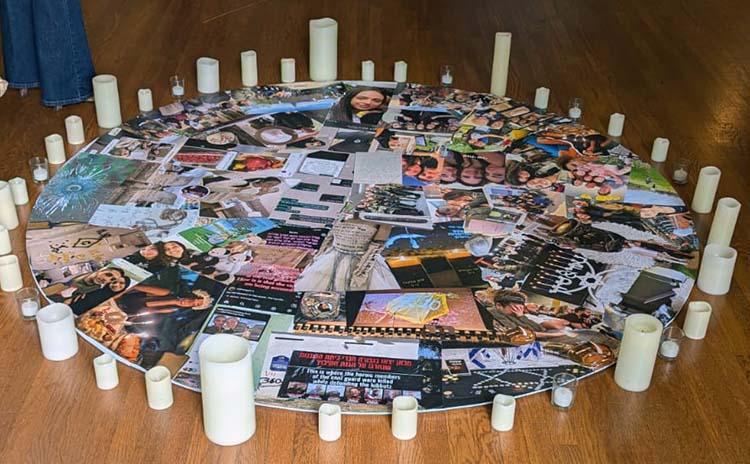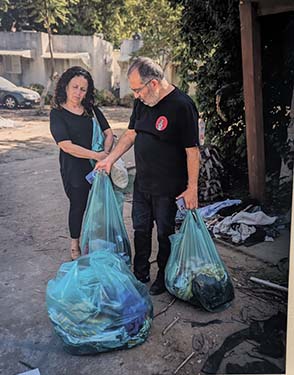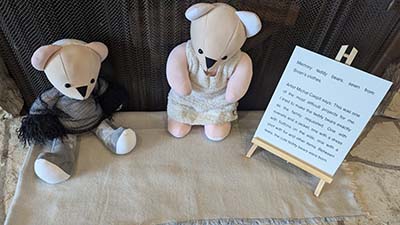
Story by Miriam Gershenson; photos by Albert Kreimerman


ENCINITAS, California — On October 7, 2023, Sivan Elkabets and her partner, Naor Hassidim, were murdered in the violent attacks that claimed the lives of over 1,200 people. The tragic event, known as Black Sabbath, marked a painful moment in history. However, Sivani’s House, an immersive exhibit installed at The Hive at Leichtag Commons, does not focus on the politics of that day. Instead, it offers an intimate look at the story of one family’s grief—a story that transcends tragedy and speaks to the universal experience of love and loss.
Created by Sivan’s parents, Anat and Shimon Elkabets, alongside her siblings, Sivani’s House invites visitors into a deeply personal journey of remembrance and healing. This exhibit is not about the external forces that led to their deaths, but rather about the lives they lived and the love they shared. It’s a story that any family, anywhere in the world, can relate to.
Before stepping into the exhibit itself, visitors are welcomed into a quiet space where they sit together and discuss the background of Sivani’s House. This gathering is not meant to dictate how visitors should feel or think but to offer context. It’s a moment to reflect and prepare for the emotional experience ahead.
The exhibit is designed to be interactive and immersive, but it also encourages a communal experience. The act of sitting together in conversation before entering creates a sense of shared humanity—reminding everyone that grief is a collective experience, one that binds us all.

As you step into Sivani’s House, you are met with a video, the centerpiece of the exhibit, which was created by Anat herself. In the video, she walks through the leftover ruins of what was once Sivan and Naor’s home. The house and the entire neighborhood have been destroyed, leaving behind only fragments of what once was.
This video serves as the emotional core of the exhibit. It’s not just a tour of a physical space, but a journey through a mother’s grief, love, and memories. The ruins are a haunting reminder of the devastation that occurred, but Anat’s steps through the rubble are filled with love, remembering not the destruction, but the life that existed there.
Beyond the video, the exhibit displays an array of personal artifacts that tell the story of Sivan and Naor’s lives. These items—photos, keepsakes, and everyday belongings—paint a picture of who they were as individuals and as a couple. Each object represents a piece of their humanity, reminding visitors that their lives were more than just a headline or a statistic.
Perhaps the most poignant part of the exhibit is the display of family text messages. These messages are exchanged during the terrorists’ arrival and destruction. They offer an unfiltered, raw glimpse into the moments of uncertainty, fear, and hope that the family experienced. These texts are not just words on a screen—they are the echoes of a family desperately trying to stay connected in the midst of unimaginable chaos.

The combination of these personal items and the text messages creates a deeply intimate atmosphere. It allows visitors to feel as though they are part of the family’s narrative, witnessing not just their grief but also their love and resilience.
Once the exhibit concludes, visitors are invited to return to the discussion area where everything began. This is a crucial part of the Sivani’s House experience, as it opens the floor for conversations about anything that came up during the visit. The exhibit does not aim to leave visitors in silence or solitude. Instead, it encourages dialogue—allowing people to process their emotions together, to ask questions, and to share their own experiences of grief and loss.
This final step transforms Sivani’s House from a passive exhibit into an active, shared experience. Visitors leave not just having witnessed a story but having engaged with it and with each other. It is a reminder that, while grief may be deeply personal, it is also something that connects us all.
The power of Sivani’s House lies in its ability to take a specific tragedy and make it universally relatable. This is not an exhibit about the politics or the conflict of the day. It’s about one family’s love for their daughter and the way they choose to remember her. It’s about the humanity that exists in all of us—the love, the loss, and the resilience that define our lives.
By focusing on the lives Sivan and Naor lived rather than the way they died, the exhibit shifts the narrative away from tragedy and towards remembrance. It reminds us that, in the end, what matters most are the connections we make, the love we share, and the stories we leave behind.
For anyone who visits Sivani’s House, the experience is an invitation to reflect not only on the lives of Sivan and Naor but on their own relationships and legacies. It’s a space where grief and healing coexist, where love endures even in the face of unimaginable loss.
The Elkabets family has given the world a precious gift through Sivani’s House—a space to remember, to feel, and to heal. In doing so, they’ve created a tribute not just to their daughter but to the enduring strength of the human spirit.
I highly recommend everyone visit Sivani’s House. The exhibit is free, and it offers a unique opportunity to connect with the human experience of grief, love, and remembrance. To learn more and schedule a visit, you can visit this website.
*
Miriam Gershenson and Albert Kreimerman are wife and husband, respectively freelance writer and freelance photographer.